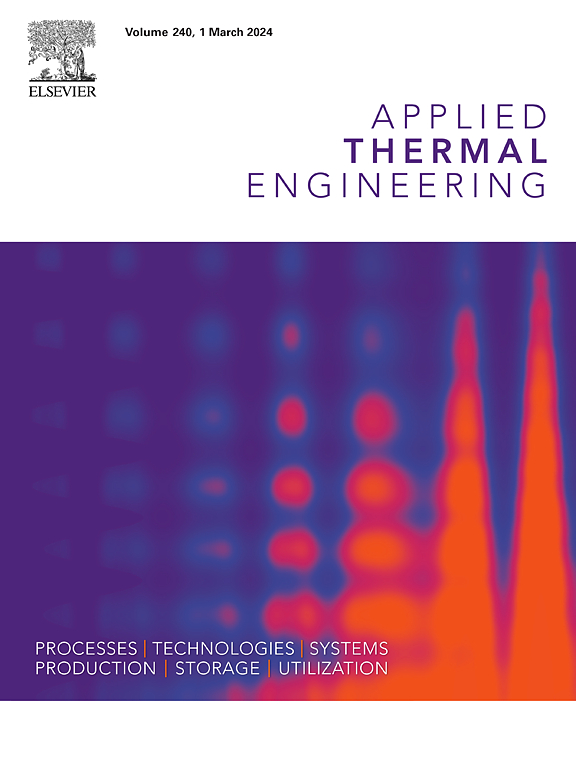Thermal management of hairpin winding traction motors in electric vehicles: Parametric evaluation of impinging oil jet cooling using CFD simulations
IF 6.1
2区 工程技术
Q2 ENERGY & FUELS
引用次数: 0
Abstract
Efficient thermal management is critical for ensuring the performance and longevity of high-power-density electric traction motors, particularly those using hairpin windings. This study aims to address the challenges of localised cooling in such systems by characterising oil jet impingement cooling using computational fluid dynamics (CFD) simulations. A detailed geometric model of hairpin windings was implemented to capture fluid-winding interactions within a 45-degree sector of the motor end winding region. The study examines key design parameters affecting cooling performance through a parametric analysis, including nozzle geometry (diameter, orientation, and distance), mounting configuration, and operational conditions (flow rate and inlet velocity). The numerical model demonstrated good agreement with experimental data, particularly in predicting heat transfer coefficient trends across different flow conditions. Results revealed that axial configurations with 2 mm nozzle diameters achieved higher heat transfer performance (940 W/m2K at 0.75 kg/min) compared to radial configurations, though this performance showed sensitivity to operational parameters. Additionally, critical velocity thresholds were identified, marking transitions between gravity-dominated and momentum-driven heat transfer mechanisms, with optimal nozzle orientations varying accordingly. Both top-mounted and radially mounted nozzle configurations were studied, with top-mounted configurations demonstrating superior spatial cooling distribution, achieving up to 370 enhancement in adjacent winding cooling at higher angular positions. These findings provide practical design guidelines for implementing efficient jet cooling systems in high-performance electric traction motors, particularly for optimising multi-nozzle array configurations to achieve effective thermal management.

电动汽车发夹绕组牵引电机的热管理:基于CFD模拟的碰撞油射流冷却参数评价
高效的热管理对于确保高功率密度电动牵引电机的性能和寿命至关重要,特别是那些使用发夹绕组的电机。本研究旨在通过使用计算流体动力学(CFD)模拟来表征油射流撞击冷却,从而解决此类系统中局部冷却的挑战。建立了一个详细的发夹绕组几何模型,以捕获电机端绕组区域45度扇形内的流体-绕组相互作用。该研究通过参数分析考察了影响冷却性能的关键设计参数,包括喷嘴几何形状(直径、方向和距离)、安装配置和操作条件(流量和入口速度)。数值模型与实验数据吻合较好,特别是在预测不同流动条件下换热系数的变化趋势方面。结果表明,与径向配置相比,直径为2mm的轴向配置具有更高的传热性能(在0.75 kg/min时为940 W/m2K),尽管该性能对操作参数敏感。此外,还确定了临界速度阈值,标志着重力主导和动量驱动传热机制之间的转变,最佳喷嘴方向也随之变化。研究人员对顶部安装和径向安装两种喷嘴结构进行了研究,顶部安装的喷嘴结构具有优越的空间冷却分布,在较高角度位置的相邻缠绕冷却效果可提高370%。这些发现为在高性能电动牵引电机中实现高效的喷射冷却系统提供了实用的设计指南,特别是在优化多喷嘴阵列配置以实现有效的热管理方面。
本文章由计算机程序翻译,如有差异,请以英文原文为准。
求助全文
约1分钟内获得全文
求助全文
来源期刊

Applied Thermal Engineering
工程技术-工程:机械
CiteScore
11.30
自引率
15.60%
发文量
1474
审稿时长
57 days
期刊介绍:
Applied Thermal Engineering disseminates novel research related to the design, development and demonstration of components, devices, equipment, technologies and systems involving thermal processes for the production, storage, utilization and conservation of energy, with a focus on engineering application.
The journal publishes high-quality and high-impact Original Research Articles, Review Articles, Short Communications and Letters to the Editor on cutting-edge innovations in research, and recent advances or issues of interest to the thermal engineering community.
 求助内容:
求助内容: 应助结果提醒方式:
应助结果提醒方式:


